Livestock and poultry inventories drop by 0.16 percent and 1.82 percent, respectively
As of January 1, 2022, the total inventory of livestock in Davao de Oro was estimated at 191,006 heads. The total figure was 0.16 percent lower than the registered 191,320 heads of the same period of last year. Of the total livestock inventory, 96.84 percent were raised on backyard farms while the remaining 3.16 percent were raised in commercial farms. The inventory of livestock in backyard farms during this period stood at 184,964 heads, 1.32 percent higher than the previous year of 182,555 heads. However, livestock raised in commercial farms posted a negative growth of 31.07 percent, from 8,765 heads to 6,042 heads this year.
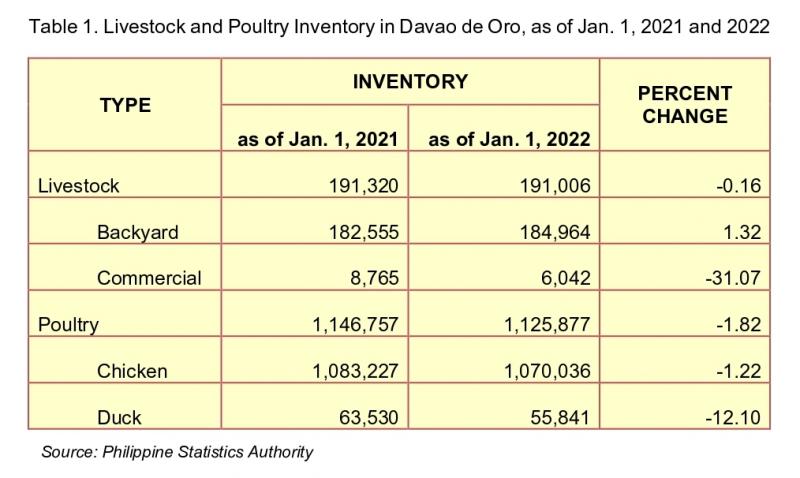
The poultry sector also declined in the total inventory by 1.82 percent, from 1,146,757 birds to 1,125,877 birds this year. Chicken had the major share in the overall inventory of poultry contributing to 95 percent, while the remaining 5 percent were ducks.
Compared with the July 1, 2021 inventory, the livestock sector grew by 3.98 percent while the poultry sector dipped by 4.14 percent this year.
Livestock Inventory
As of January 1, 2022, the total inventory of carabao in Davao de Oro has the highest decrease among livestock inventories, 7.34 percent, from 21,934 heads to 20,325 heads this year. Cattle inventory remained stable at 0.01 percent compared to last year. Goat, on the other hand, was observed to have positive growth in inventory, 6.37 percent from 35,305 heads to 37,553 heads this year (Figure 1).
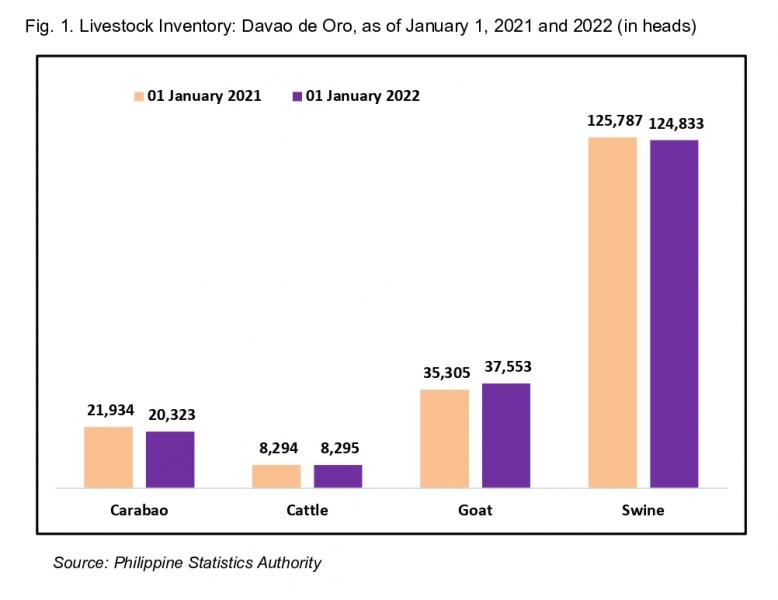
In the province, 99 percent of carabao, cattle, and goat were tended in backyard farms while the remaining 1 percent were raised in commercial farms.
Swine in Davao de Oro has the highest inventory, 65.35 percent of the total livestock inventory on January 1, 2022. It was estimated at 124,833 heads, however, 0.76 percent lower than the inventory of 125,787 heads of the same period of last year. In the latest count of swine in the province, about 95.22 percent were tended in backyard farms while 4.78 percent were raised in commercial farms (Figure 2).
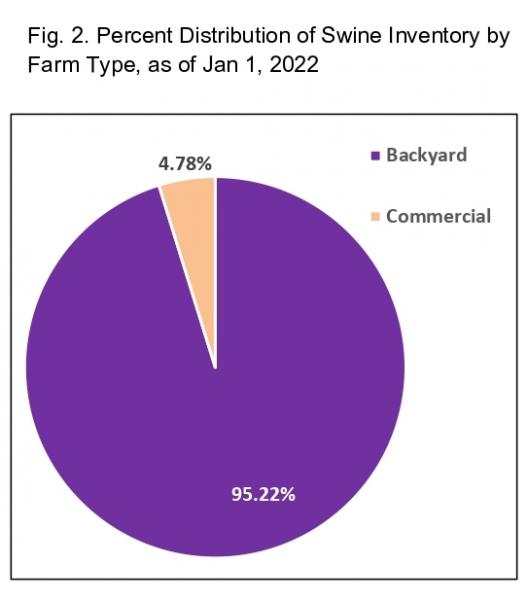
The inventory of backyard swine during this period was recorded at 118,869 heads, 1.42 percent higher than the previous year. However, commercial swine declined by 30.52 percent this year (Figure 3).
Among the domesticated animals present in the livestock farms, compared with the July 1, 2021 inventory, carabao and cattle’s inventories dipped by 4.32 percent and 1.97 percent, respectively. On the other hand, inventories for swine increased by 5.41 percent while for goat it increased by 5.59 percent.
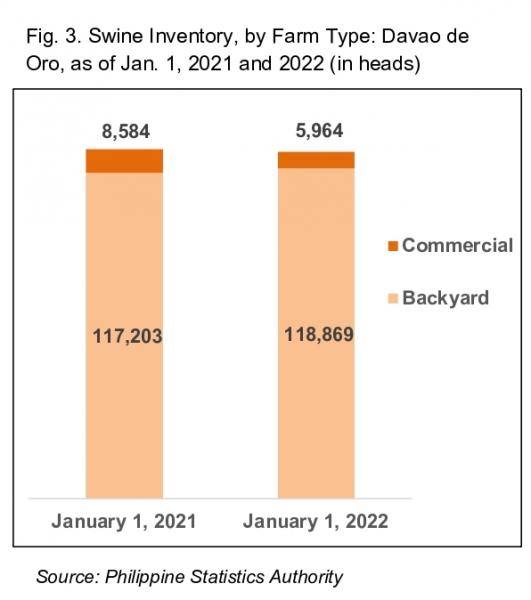
Chicken Category
The total inventory of chicken in Davao de Oro dropped to 1,070,036 birds, 1.22 percent lower than the 1,083,227 birds estimated in the same period of last year. Native/Improved chicken largely contributed to the decline in the inventory which was 1.46 percent lower compared to last year. Broiler chicken was also seen to slightly reduced by 8.50 percent, from 72,380 birds to 68,386 birds this year. Layer, on the other hand, is the only type that had increased its inventory this year, by 11.06 percent (Figure 4).
Among the types, the native chicken had the largest share of stocks to the total chicken inventory with 87.41 percent or 935,420 birds. Broiler and layer followed by exhibiting 6 percent each of the total chicken inventory (Figure 5).
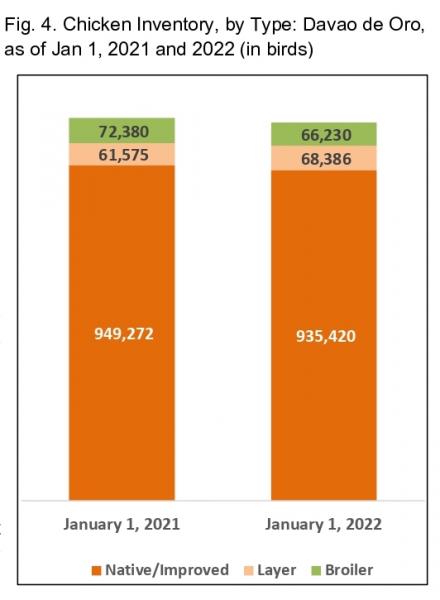
Compared with the total chicken inventory over the previous round, July 1, 2021, will also show a decrease of 3.77 percent. The negative growth was mainly due to the decline in the inventory of native/improved chicken which dipped by 5.27 percent, followed by layers at 8.62 percent. Meanwhile, broiler chicken is the only chicken type that posted a positive growth, 33.40 percent, higher than the previous round.
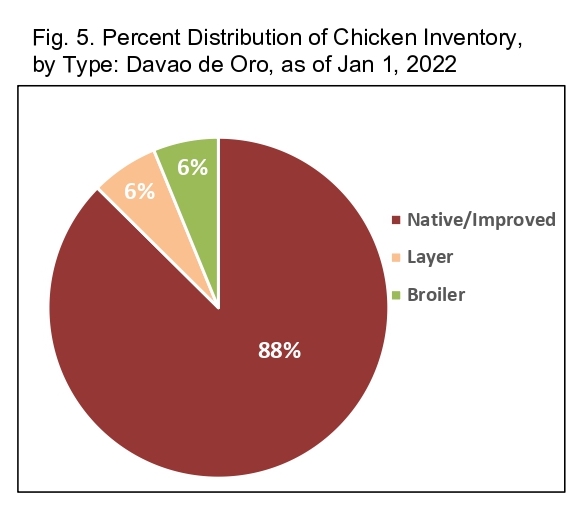
Duck Inventory
The total inventory of ducks in Davao de Oro on January 1, 2022, was estimated at 55,841 birds, 12.10 percent lower than the total inventory of 63,530 birds of the same period of last year. The decrease was attributed to the decline in the number of ducks in commercial farms (Figure 6).
Compared with the total duck inventory over the previous round, July 1, 2021, will also show a decline in the number of stocks at 10.71 percent.
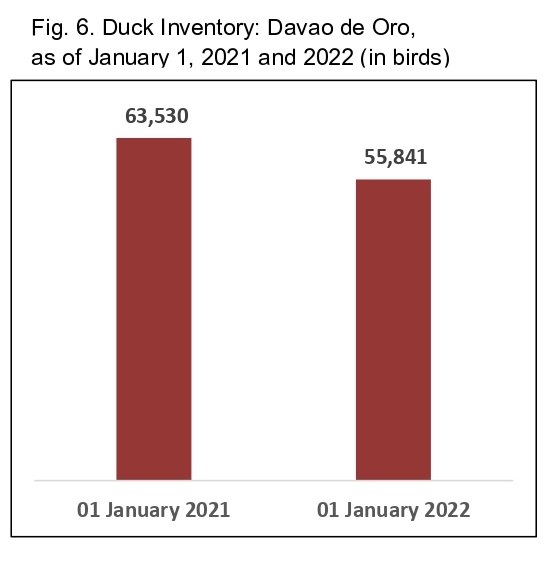
TECHNICAL NOTES
The Backyard Livestock and Poultry Survey (BLPS) and the Commercial Livestock and Poultry Survey are two of the four major surveys for livestock and poultry. The BLPS and CLPS are national surveys of which BLPS covers backyard farms on carabao, cattle, goat swine, chicken (broiler and layer) and duck in all four rounds. CLPS, on the other hand covers commercial farms on swine and chicken (broiler and layer) for minor rounds; and additional carabao, cattle, goat, and duck for major rounds.
Both surveys are important as the data generated will aid policymakers in generating sound policy decisions on the improvement of backyard and commercial farms for the welfare of the farmers and operators. Moreover, the survey will determine/measure the performance of the livestock and poultry industry and the agriculture sector, as a whole.
Livestock refers to farm animals kept or raised for consumption, work, or leisure. For purposes of censuses and surveys, livestock covers only those that are tended and raised by an operator.
Poultry is a collective term for all domesticated avians for the purpose of food consumption or, the carcass of such avian dressed/processed for human consumption.
Animal Inventory (also, Animal Population) is the number of domesticated animals in head present in the farm at specific reference date.
Commercial Livestock Farm/Operator refers to any livestock operator or farm which operation satisfies at least one of the following conditions: a.) at least 21 heads of adult and zero head of young b.) at least 41 heads of young animals c.) at least 10 heads of adult and 22 heads of young
Commercial Poultry Farm/Operator refers to any poultry operator or farm which operation satisfies at least one of the following conditions: a.) 500 layers, or 1,000 broilers b.) 100 layers and 100 broilers if raised in combination c.) 100 head of duck regardless of age
Backyard Farm/Raiser- refers to any farm or household raising at least one head of animal or bird and does not qualify as a commercial farm.
Starting April 2022 Round, CLPS shall cover all animal commodities: carabao, cattle, swine, goat, sheep, broiler, layer, and duck. The CLPS will use the results of the 2021 Updating of the List of Establishments (ULE) as sampling frame.
